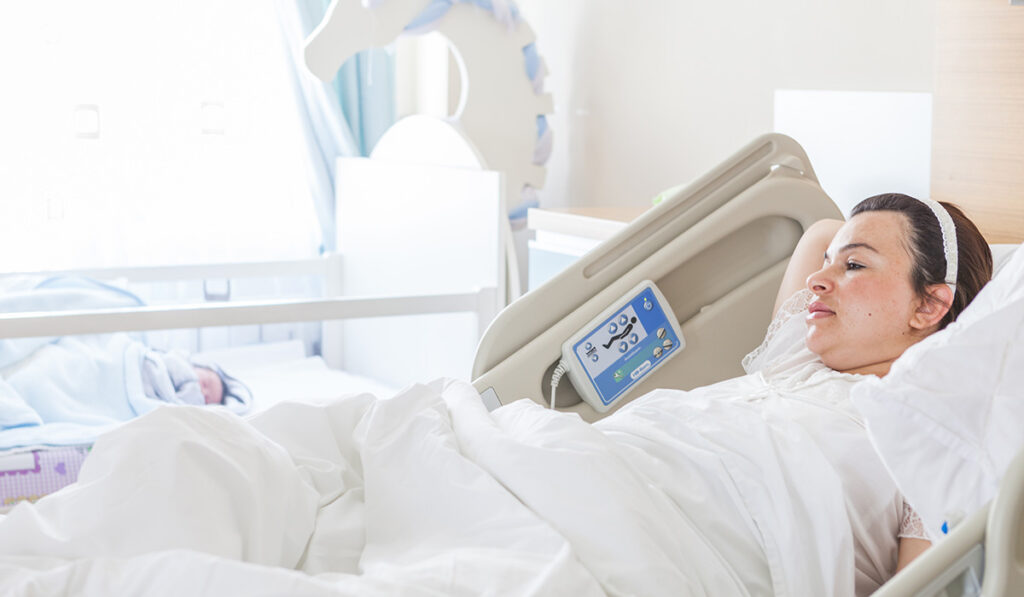A novel prediction model weighing just three factors – inpatient opioid use, tobacco use, and the presence of depression or anxiety – is an accurate tool for estimating outpatient opioid use after cesarean birth, according to a new report in Obstetrics and Gynecology.
The study represents the first validated model for predicting opioid needs in patients who underwent a C-section and is the latest report from researchers at Vanderbilt University Medical Center investigating opioid prescribing after childbirth.
“We want to achieve an ideal balance of matching opioid prescribing to actual usage,” said Sarah Osmundson, M.D., lead author on the study and an associate professor in the Division of Maternal Fetal Medicine at Vanderbilt. “That’s really the goal of our work, to individualize opioid prescribing, because for many years we have been doing this kind of one-size-fits-all prescribing practice.”
“We want to achieve an ideal balance of matching opioid prescribing to actual usage.”
Osmundson and colleagues are now completing external validation to determine whether the same predictors identified in the new study are associated with outpatient opioid use in other states and regions.
Risks in Prescribing
Prior research from Osmundson and colleagues has documented risks associated with opioid prescribing after childbirth, including a study published in Annals of Internal Medicine, which showed an increase in the risk of serious opioid-related events, including persistent opioid use, overdose and death.
Her team has also shown that most women following cesarean birth are prescribed opioids in excess of the amount needed. By adopting an individualized opioid prescribing approach, physicians can help reduce the number of unused opioid tablets without compromising pain outcomes.
Yet, Osmundson also cautions against sweeping reductions.
“I do have worries that, as we have more restrictions on what clinicians can prescribe, there is a risk of under-prescribing, which has associated consequences,” she said. “There’s a lot of variation among patients. Pain management strategies that work well for one patient might be a terrible experience for another. We need to be able to customize pain management for patients with different pain experiences.”
“We need to be able to customize pain management for patients with different pain experiences.”
The new model aims to address these concerns while also making the change convenient for clinicians.
A Tool to Predict Pain
The prospective study enrolled 459 participants between 2019 and 2020. Questionnaires were used to evaluate pain and opioid use, and clinical data were abstracted from the EHR.
Based on prior research and clinical expertise, a total of 34 predictors were identified and used to build a primary model. In this model, inpatient opioid use alone accounted for 56.4 percent of the variability, corroborating reports of consistent associations between inpatient and outpatient opioid use.
In a second model using only the three key predictors – inpatient opioid use, tobacco use, and presence of depression or anxiety – the researchers achieved 90 percent performance as compared to the primary model. A third model was built using 17 predictors available within the EHR. All three models demonstrated high predictive accuracy.
Promising Trends
Trends across Osmundson’s research suggest patients undergoing cesarean birth are being more intentional when it comes to decisions related to opioids. Compared to a 2018 study led by her team, in which 13 percent of participants used no opioids after discharge, the new study finds this number has jumped to 23.5 percent.
“There are two factors going on,” Osmundson said. “One, clinicians are prescribing less. And there’s an association between the amount of opioids prescribed and what patients use. At the same time, we think there is also a trend among patients to use less opioids.
“When we talk to patients, they’re much more aware of concerns about opioid addiction, and more patients are open to the idea of not using any opioids after C-section. Five years ago, you would never have said that.”
Automated Recommendations
For convenient implementation, the team is working to incorporate the model into the EHR. A more time-intensive tool now in use requires clinicians to gather the necessary data and manually calculate prescriptions.
“We are working right now on building a clinical decision support tool in the Vanderbilt EHR that gathers the information for clinicians and gives them a recommendation at the point that they’re about to write a prescription,” Osmundson said. “That’s a complex task in and of itself, but something that we’re pretty close to completing.”





